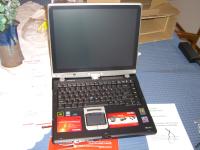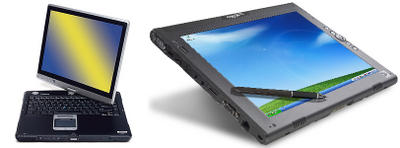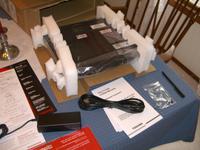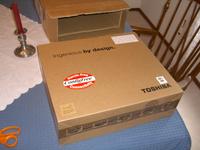Toshiba Tecra M4 In-Depth Review (Page 1)
 I should probably start this thing with a disclaimer: This is my first attempt at a review of a computer, despite years of experience using them. I should also note that I am by no means a professional; I’m a Professional Flight student at Purdue (Go Boilers!) and working full time during the summer doing webstore development and tech support for a small software company.
I should probably start this thing with a disclaimer: This is my first attempt at a review of a computer, despite years of experience using them. I should also note that I am by no means a professional; I’m a Professional Flight student at Purdue (Go Boilers!) and working full time during the summer doing webstore development and tech support for a small software company.Also, a note to my regular readers: This is my attempt at a review of my new Tablet PC, so those of you who aren’t “technophilies” can feel free to skip it (although I would hope that you would be curious and read it through anyway). I’ve tried to write it so that people mostly unfamiliar with the Tablet world can make some sense of it. I probably will not be making regular comments on this blog about using a Tablet (I’ll leave that to more experienced individuals like Rob Bushway or Eric Mack), so regular readers need not fear my blog being transformed into a “Tablet evangelizing” site.
Now, onto the review:
2. Body and Design, Build Quality Issues, Size and Weight
3. Screen Mini-Review I: Resolution, Brightness, and Glare
4. Screen Mini-Review II: Outdoor Viewing
5. Screen Mini-Review III: Viewing Angle
6. Setup, RAM Upgrade, Background Processes
7. Toshiba Power Saver, Undervolting/Centrino Hardware Control, and Battery Life
8. Timings, Video Driver and 3DMark03 Performance, and Sound
Introduction
 The Toshiba Tecra M4 convertible Tablet PC is one of the largest, most powerful models on the market today. It weighs in at a hefty 6.2 pounds, featuring a Sonoma chipset, a real video card (verses video being integrated into the motherboard like most tablets), and a 14.1” SXGA+ display. It runs Microsoft Windows XP Tablet Edition 2005, which is basically XP, Service Pack 2, and the pen interface all grafted together. By “tablet” and “pen” I do not mean a touch screen like you would find on a PDA, instead it requires a special digitizer pen made by Wacom.
The Toshiba Tecra M4 convertible Tablet PC is one of the largest, most powerful models on the market today. It weighs in at a hefty 6.2 pounds, featuring a Sonoma chipset, a real video card (verses video being integrated into the motherboard like most tablets), and a 14.1” SXGA+ display. It runs Microsoft Windows XP Tablet Edition 2005, which is basically XP, Service Pack 2, and the pen interface all grafted together. By “tablet” and “pen” I do not mean a touch screen like you would find on a PDA, instead it requires a special digitizer pen made by Wacom.For those of you who have not been following the Tablet market, this screen is a big deal, no other model features a resolution this high on a 14” screen. Virtually all other models have displays that are XGA resolution (with the exception of two 12” models, a Toshiba and a Fujitsu, with SXGA+). I will be spending a lot of time on the screen later because of how important it is.
You can use the Tablet of Contents above to navigate the various pages of this review. I have also created a site at Flickr.com to host high resolution versions of the same pictures you see in this review (and a few others), the link is at the bottom of the Table of Contents.
Convertible vs. Slate
So what does it mean to have a “convertible” Tablet? “Convertible” means that you can operate it like a normal laptop, but you can also rotate the screen around 180 degrees to close the lid with the display facing outward (so you can “ink” on it, aka use the digital pen). “Slate” models don’t have this functionality; they are basically just screens without the keyboard. Slates are typically smaller and lighter than convertibles (more focused toward mobility), but are usually less powerful and universally lack optical drives. Convertibles are larger and heavier, but usually have more computing “oomph.” I chose a convertible because I wanted the larger, high-resolution screen and I felt that my personal usage patterns require the keyboard enough that I would lose productivity to go “pure Tablet.”

Specifications
Intel Pentium M 760 2.0 Ghz
Sonoma (second generation Centrino chipset)
256 MB ram (quickly replaced by 2 Gb of Transcend DDR2 533Mhz RAM off Newegg)
NVidia Geforce Go 6600 TE w/ 128 Mb
60 Gb 5400 rpm SATA Hard Drive
DVD+/-RW DL Super-Multi Drive
Intel Pro/Wireless 802.11a/b/g
Integrated Bluetooth
3 year SystemGuard accidental damage protection warranty
Slim-Select Bay secondary Li-ion battery
Packaging/Contents


I ordered my customized M4 on June 10th from Toshiba Direct. They took their time building it, but it eventually did ship on Monday, June 20th. I got the 3-7 day ground shipping from FedEx (cheapest shipping Toshiba offered), so I wasn’t expecting it until the end of the week at the earliest. Boy was I wrong; FedEx managed to get it all the way from China to my family’s house in the Chicago area by 9:30am Wednesday (June 22nd) morning! Needless to say, I was most impressed.
The M4 came securely packed from Toshiba. No complaints in this department. I still don’t have the paperwork on my SystemGuard warranty (Toshiba’s order status page said it shipped well over 2 weeks ago, but never gave me any tracking information, I guess I’ll have to call them) and they still haven’t shipped the secondary battery.

Secret Decoder Ring!
A small ring-like piece of metal with a gap in it is usually included with new Tablets. Because they don’t include any documentation on it, new Tablet users are often confused, hence the “super secret decoder ring” nickname from longtime users. Its actual function is to remove worn-down pen nibs. The picture shows it on my pinky next to the pen and the extra nibs Toshiba included in the box (for the record, I don’t actually wear it; I just put it on for the picture).

Pages: 1, 2, 3, 4, 5, 6, 7, 8, 9, 10, Pictures


11 Comments:
Nicely done. Really like the pictures.
Great job, Shawn!
Good, thorough review - your point about build quality applies to my, recently purchased Portege M200: the screen doesn't sit flush with the keyboard/base unit when the screen is closed. I'm not that concerned, however: the machine is otherwise very solid.
Thanks for the compliments on the review!
hmd,
The M4 will get pretty hot under heavy use for long periods of time. I have a feeling it'd be too hot to use in your lap, but would be ok on a desk. If you're going to put it under that kind of heavy use on a regular basis, I'd suggest getting a cooling pad or something similar to help keep it cool.
Thanks Shawn for the review and the answers
I am wondering which laptop to purchase Toshiba Tecra M4 or Qosmio F25 . I am a student that uses computer regularly and would like to take notes ONE TIME only in the lecture but I am afraid that the screen will be small for a log time access ?
Do the Microsoft® Windows® XP Media Center Edition 2005 support other languages ?
Thanks again
Shawn, thanks for the "unprofessional" review. It was more informative than any I've read so far. I'm trying to decide between the M4 and a Fujitsu Lifebook. Setting aside the weight, I think your review tipped the scales in the M4's favor. Thanks for taking the time to post your findings.
nate
good review. i'm glad you pointed out some of the not-so-positive aspects of the notebook - others try to convince themselves they own the best notebook ever, and so the reflective screen becomes "a very useful mirror.." and the poor viewing angle a security feature.
Also, the comparison photos are easily the best (& most useful) i've ever seen in a notebook review.
Vlad
(dimalife)
Hi Shawn,
I really enjoyed your review and it has been tremendously useful, since I just got an M4 this past weekend. I too am suffering from having to remove all the additional software crap that Toshiba has loaded on the machine. Did you ever consider blowing away their image and creating your own? Thanks,
Kim
Shawn,
I have a M4 and about 2 weeks after receiving and using it, its begun emitting a very high frequency sound from the vent between the battery and HDD. Do you know of any other M4s that do this? I dont know if this is normal.. but it sure hurts your ears after a while in a quiet room.
Steve Mac
Cool review. Found someothers as well:
www.tabletpcbuzz.com
www.fastknow.com
My tecra often starts up again after being shut down. This often means that it is on when in my travelling backpack. Has anyone else had theis problem? If there some way to fix it.
Post a Comment
<< Home